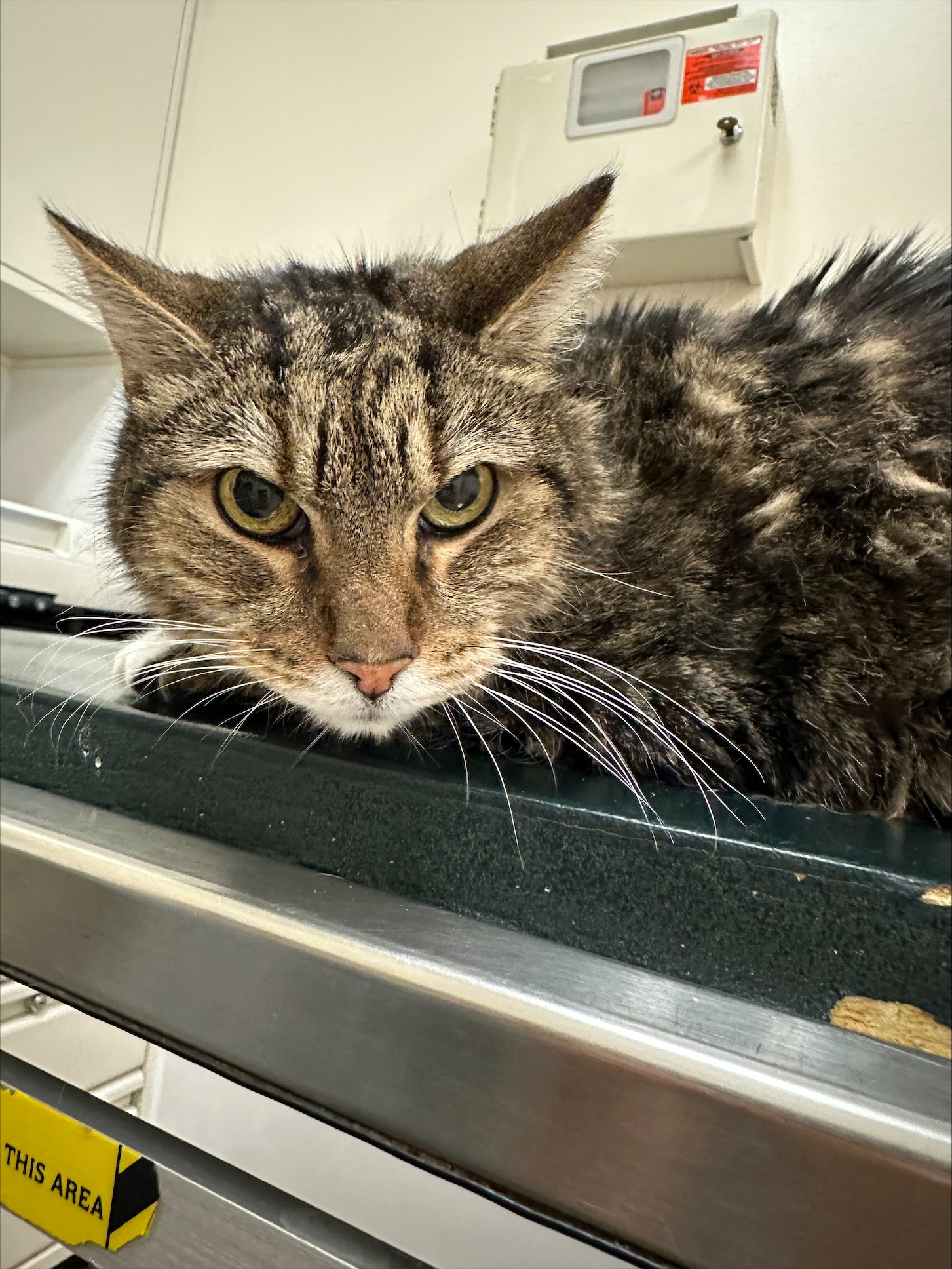ニュース
こんにちは、小西啓介です。
CSUでの内科レジデントプログラムを開始してから、早くも半年が経ちました。CSUには世界各国から多様なバックグラウンドを持つ人々が集まるため、最初は英語のリスニングに苦労しました。特に、出身国ごとに異なるアクセントや発音に慣れるのに時間がかかりましたが、今ではだいぶ聞き取れるようになり、会話にも支障がなくなってきました。改めて、人間の適応力は年齢を問わず備わっているものだと実感しています。どんな年齢でも、新しいことに挑戦する価値はあると感じています。たとえ思うようにいかなくても、そこから得られる学びは必ず自分の成長につながるはずです。
新卒獣医師向け診断学セミナーの実施
VCA Japanの取り組みの一環として、1月から新卒獣医師向けの診断学セミナーをオンラインで開催しています。このセミナーは、1年目の獣医師を対象とした教育プログラムの一部であり、これまでの新卒獣医師向けセミナーで学んできた知識を実際の臨床に応用することを目的とした集大成的なプログラムです。内容は、最新の『Ettinger’s Textbook of Veterinary Internal Medicine』を基に、論文やCSUでの学びを取り入れながら、症状別の鑑別診断を解説するものとなっています。
また、このセミナーはWoof Universityにも見逃し配信と資料が掲載されています。Woof UniversityはVCA Japanのスタッフのみが利用できる教育ポータルサイトであり、1年目の獣医師だけでなく、より経験を積んだ先生方にも役立つ内容となっていますので、VCA Japanの社員の方はぜひご覧ください。
興味深い症例紹介:高齢猫の消化器型リンパ腫
CSUでは現在、病院スタッフの飼い猫の症例を担当させていただいています。非常に興味深いケースなので、学びのポイントを共有したいと思います。

症例概要 15歳の去勢雄のドメスティックショートヘアーが、慢性的な間欠的嘔吐と著しい体重減少、削痩を主訴に来院しました。高齢猫の体重減少の主な鑑別診断としては、甲状腺機能亢進症、慢性腎臓病、慢性腸症、リンパ腫、心筋症などが挙げられます。
血液検査、生化学検査、尿検査、甲状腺パネル、Texas GIパネル(fTLI, fPL, コバラミン, 葉酸)、腹部超音波検査、心エコーを実施し、鑑別診断を進めました。その結果、慢性的な再生性貧血、コバラミン1000 over(高値)、小腸の筋層肥厚、腹腔内リンパ節の軽度腫大が認められました。消化管原発性の異常が疑われたため、内視鏡生検を実施したところ、胃および結腸はリンパ球性形質細胞腸炎、十二指腸および回腸は小細胞性T細胞性リンパ腫と診断されました。

学びのポイント
コバラミン高値(1000 over)の解釈
コバラミンは唯一、血液検査で小腸(回腸)の異常を特異的に見つけることができる有用な指標ですが、通常は消化吸収能が低下する疾患では低値を示します。しかし、高値となるケースも論文で報告されており、主に肝疾患、腫瘍、消化器疾患、腎疾患、炎症性疾患などで増加することが知られています。そのため、コバラミン高値の症例では消化器疾患のみならず、全身性の疾患がないか再評価する必要があります。
病理診断とクローナリティ検査の不一致
本症例では、リンパ球クローナリティ検査(PARR)により、胃・十二指腸・回腸・結腸すべての領域でT細胞モノクローナル(T細胞性リンパ腫の疑い)との結果が出ました。しかし、病理検査では胃と結腸はリンパ球性形質細胞腸炎と診断されました。CSUの米国獣医病理学専門医に相談したところ、近年の報告では、病理検査で慢性腸炎と診断されても実際にはリンパ腫細胞と慢性炎症が混在し、初期段階では病理学的にリンパ腫と診断できないケースがあるとのことでした。そのため、病理検査の結果が常に絶対ではなく、クローナリティ検査を併用することで診断の確実性が向上することが示唆されました。
慢性の再生性貧血の原因について
一般に再生性貧血は急性経過で溶血や出血所見が認められますが、本症例ではそのような所見はなく、軽度の再生性貧血が緩徐に進行していました。IMHA(免疫介在性溶血性貧血)の除外のため、赤血球凝集試験は陰性、クームス試験は弱陽性(1:8)でしたが、健康な猫でもクームス試験が陽性となることがあるため、IMHAの診断基準を満たしませんでした。消化管型リンパ腫とプレドニゾロン投与の影響からオカルト消化管出血も疑い、便潜血検査を実施しましたが陰性でした。この検査は偽陽性は多いものの、偽陰性は少ないため、教員も不思議に思っていました。また、私の研究テーマでもあるMycoplasma haemominutumも慢性の再生性貧血を引き起こすことがあるため、プレドニゾロン投与前後に計3回PCR検査を実施しましたが、すべて陰性でした。
現在、この謎を解明するためにさらに文献を調査しており、関内どうぶつクリニック勤務時代の症例も含めてレトロスペクティブ研究を進めています。VCA Japanの先生方で類似症例をお持ちの方は、ぜひ共同研究として症例を提供していただければ幸いです。
おわりに
CSUでの学びを通じて、診断学や研究において新たな視点を得ることができています。今後も、実際の臨床に役立つ情報を皆様と共有していければと思います。
Hello, this is Keisuke Konishi.
It has already been six months since I started the Internal Medicine Residency Program at CSU. Since CSU attracts people from various countries with diverse backgrounds, I initially struggled with listening comprehension in English. In particular, it took time to get used to the different accents and pronunciations depending on the speaker’s country of origin. However, I have now become much more accustomed to them and can engage in conversations without much difficulty. Once again, I am reminded that human adaptability is something we possess regardless of age. I believe that no matter how old we are, it is always worthwhile to take on new challenges. Even if things don’t go as planned, the insights gained from the experience will always contribute to personal growth.
As part of VCA Japan’s initiatives, we have been conducting an online diagnostic medicine seminar for new graduate veterinarians since January. This seminar is part of the educational program for first-year veterinarians and serves as a culmination of the knowledge they have gained in previous seminars, with the goal of applying it in clinical practice. The content is based on the latest edition of Ettinger’s Textbook of Veterinary Internal Medicine and incorporates research papers as well as knowledge acquired at CSU to provide a symptom-based approach to differential diagnosis.
Additionally, this seminar is available on Woof University, where both recorded sessions and accompanying materials can be accessed. Woof University is an educational portal site exclusively for VCA Japan employees, making it useful not only for first-year veterinarians but also for more experienced professionals. If you are a VCA Japan employee, I encourage you to take advantage of this resource.
At CSU, I am currently handling a case involving a staff member’s pet cat. This case is particularly intriguing, so I would like to share some key learning points.
A 15-year-old neutered male domestic shorthair cat presented with chronic intermittent vomiting, significant weight loss, and cachexia. The primary differential diagnoses for weight loss in senior cats include hyperthyroidism, chronic kidney disease, chronic enteropathy, lymphoma, and cardiomyopathy.
To refine the differential diagnosis, we conducted blood tests, biochemical analysis, urinalysis, a thyroid panel, a Texas GI panel (fTLI, fPL, cobalamin, folate), an abdominal ultrasound, and an echocardiogram. The results revealed chronic regenerative anemia, a cobalamin level over 1000 (elevated), thickening of the small intestinal muscularis layer, and mild enlargement of abdominal lymph nodes. Given the suspicion of a primary gastrointestinal disorder, an endoscopic biopsy was performed, which confirmed lymphoplasmacytic enteritis in the stomach and colon, and small-cell T-cell lymphoma in the duodenum and ileum.
Cobalamin is a valuable marker that can specifically detect abnormalities in the small intestine (ileum) through blood testing. Typically, cobalamin levels decrease in conditions that impair digestive absorption. However, some cases have been reported in the literature where elevated cobalamin levels are observed. These cases are mainly associated with hepatic disease, neoplasia, gastrointestinal disorders, renal disease, and inflammatory conditions. Therefore, when encountering elevated cobalamin, it is essential to reassess not only gastrointestinal disorders but also the possibility of systemic diseases.
In this case, PCR for Antigen Receptor Rearrangement (PARR) testing revealed T-cell monoclonality (suggesting T-cell lymphoma) in all examined regions: stomach, duodenum, ileum, and colon. However, histopathology diagnosed the stomach and colon lesions as lymphoplasmacytic enteritis. Consultation with a board-certified veterinary pathologist at CSU revealed that recent reports indicate early-stage lymphoma can be histologically indistinguishable from chronic inflammation. In such cases, lymphoma cells and chronic inflammation may coexist, and at an early stage, histopathology alone may not be sufficient for a definitive diagnosis. Thus, relying solely on histopathology may not always provide an accurate diagnosis, and combining it with clonality testing can enhance diagnostic accuracy.
Regenerative anemia is typically associated with acute hemolysis or hemorrhage, but in this case, there was no clear evidence of either, and the mild regenerative anemia was progressing gradually. To rule out immune-mediated hemolytic anemia (IMHA), we conducted an autoagglutination test, which was negative, and a Coombs test, which showed weak positivity (1:8). However, since healthy cats can also test positive in the Coombs test, the findings did not meet the diagnostic criteria for IMHA. Given the presence of gastrointestinal lymphoma and prednisolone treatment, we also suspected occult gastrointestinal bleeding and performed a fecal occult blood test, which was negative. This test tends to yield many false positives but few false negatives, so the negative result puzzled even the faculty.
Additionally, my research topic, Mycoplasma haemominutum, is known to cause chronic regenerative anemia. To investigate this possibility, we performed PCR testing three times—before and after prednisolone administration—but all results were negative.
Currently, I am continuing a literature review to further explore the cause of this phenomenon. Moreover, I have encountered three cases of chronic regenerative anemia in cats during my time at Kannai Animal Clinic, which has led me to initiate a retrospective study on this topic with the support of my faculty advisors. If any VCA Japan veterinarians have encountered similar cases, I would greatly appreciate the opportunity to collaborate and include these cases in our research.
Through my experiences at CSU, I am gaining new perspectives on diagnostics and research. Moving forward, I hope to continue sharing insights that will be beneficial in clinical practice.